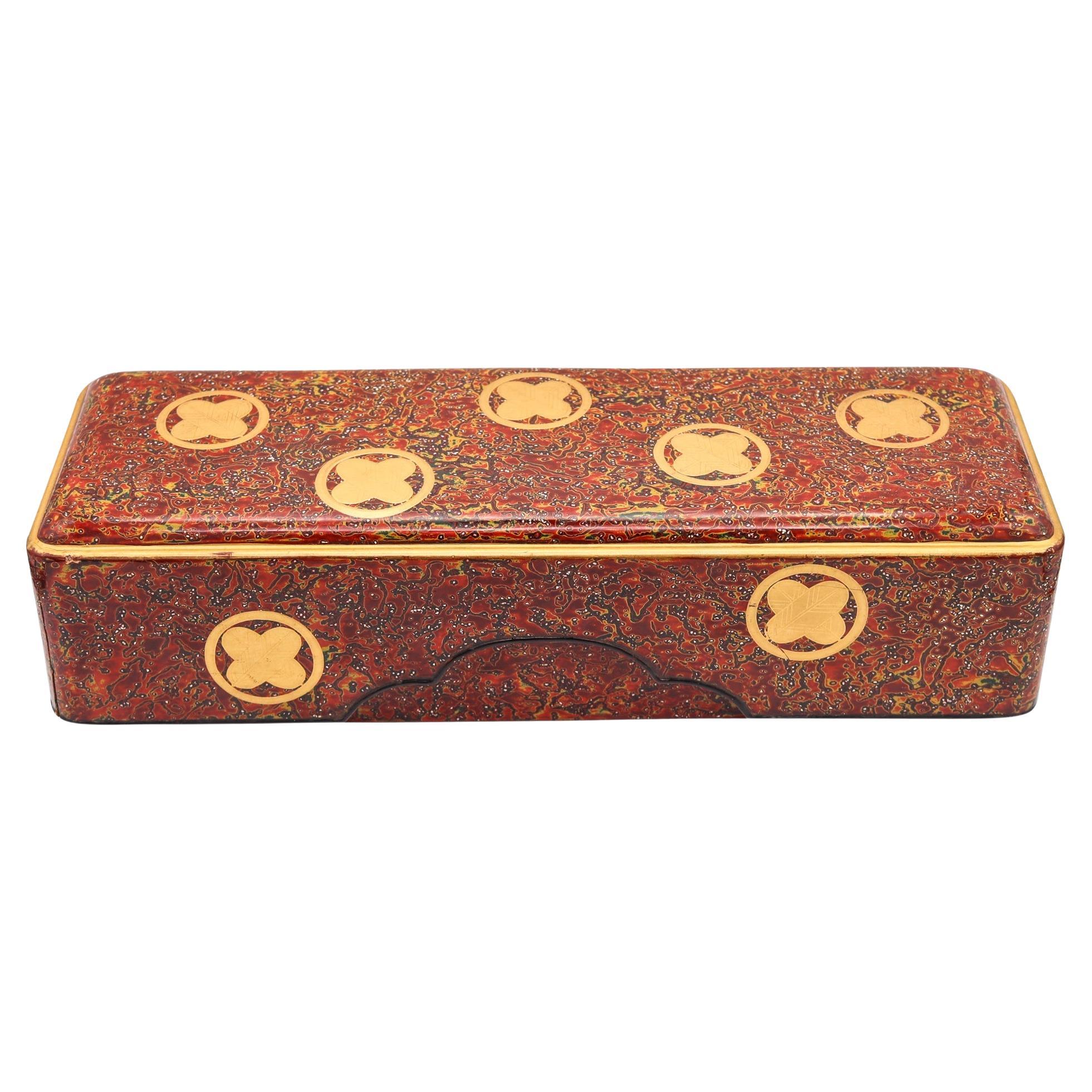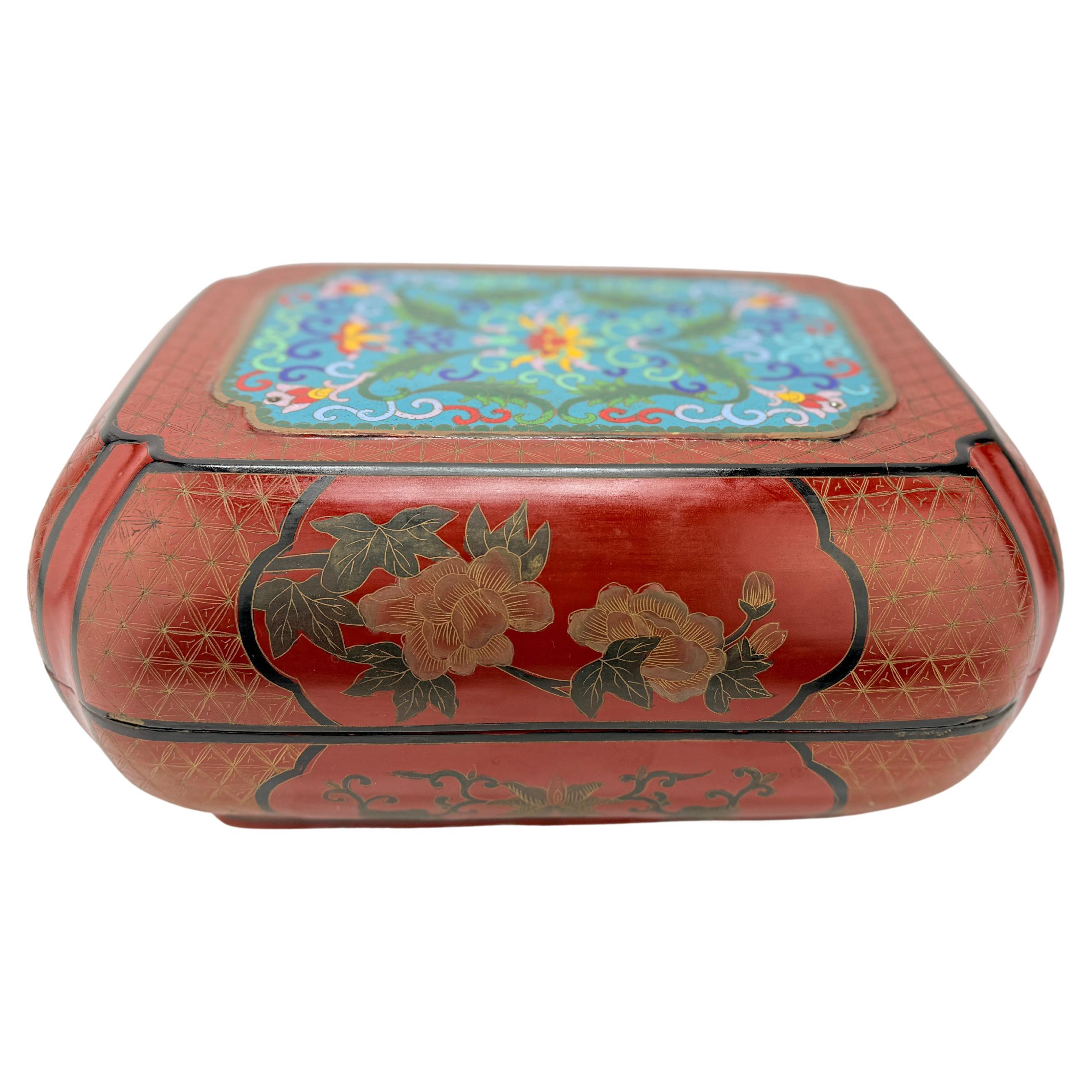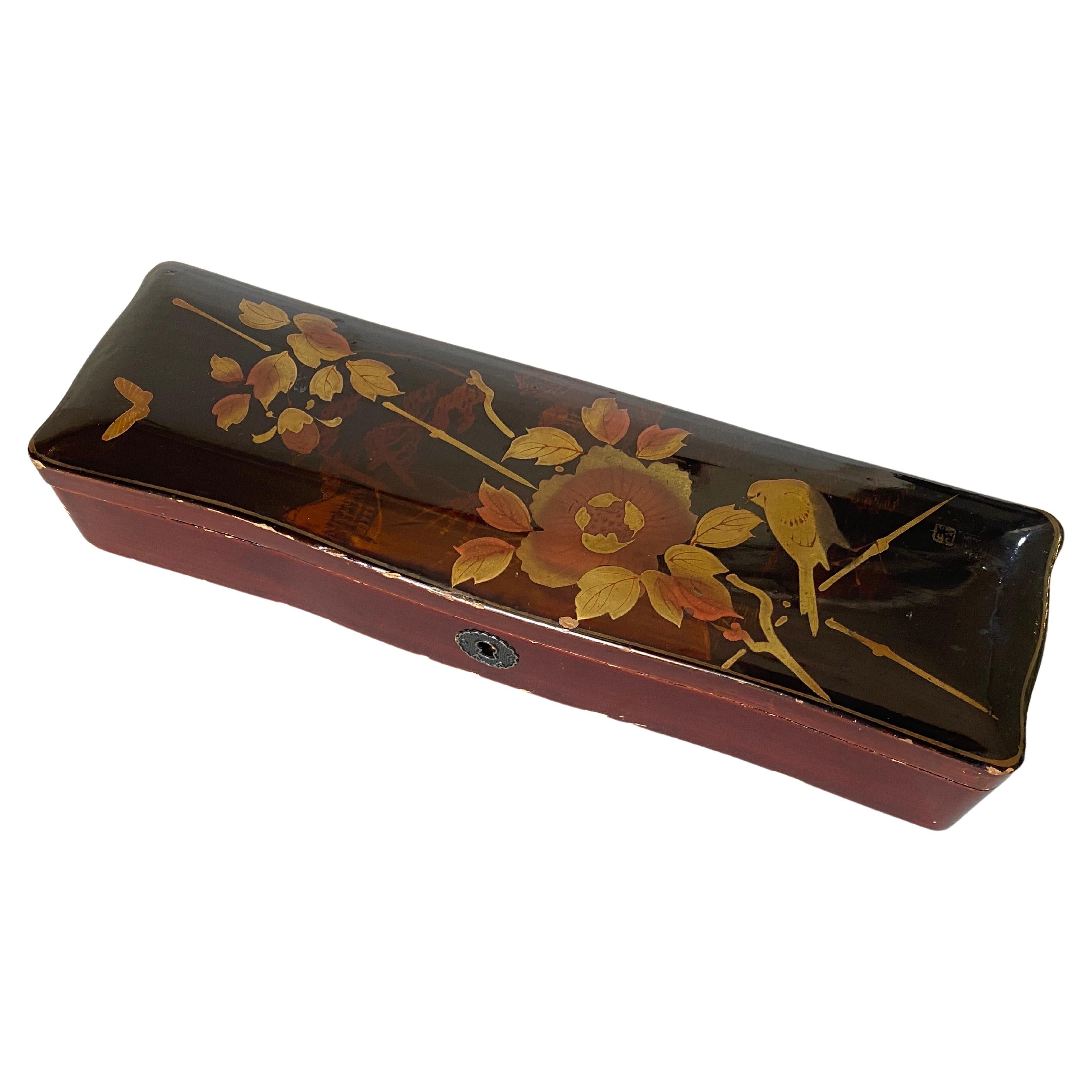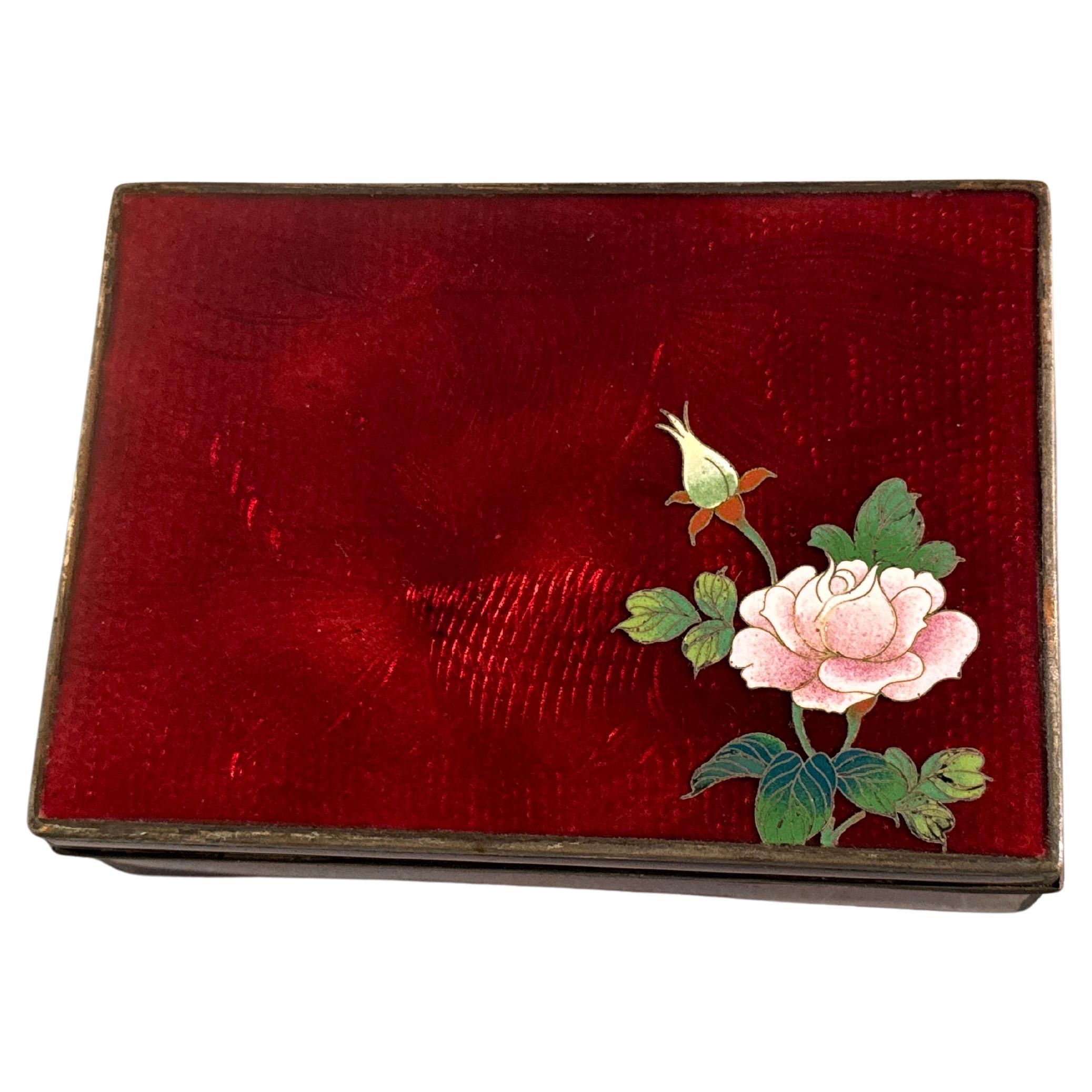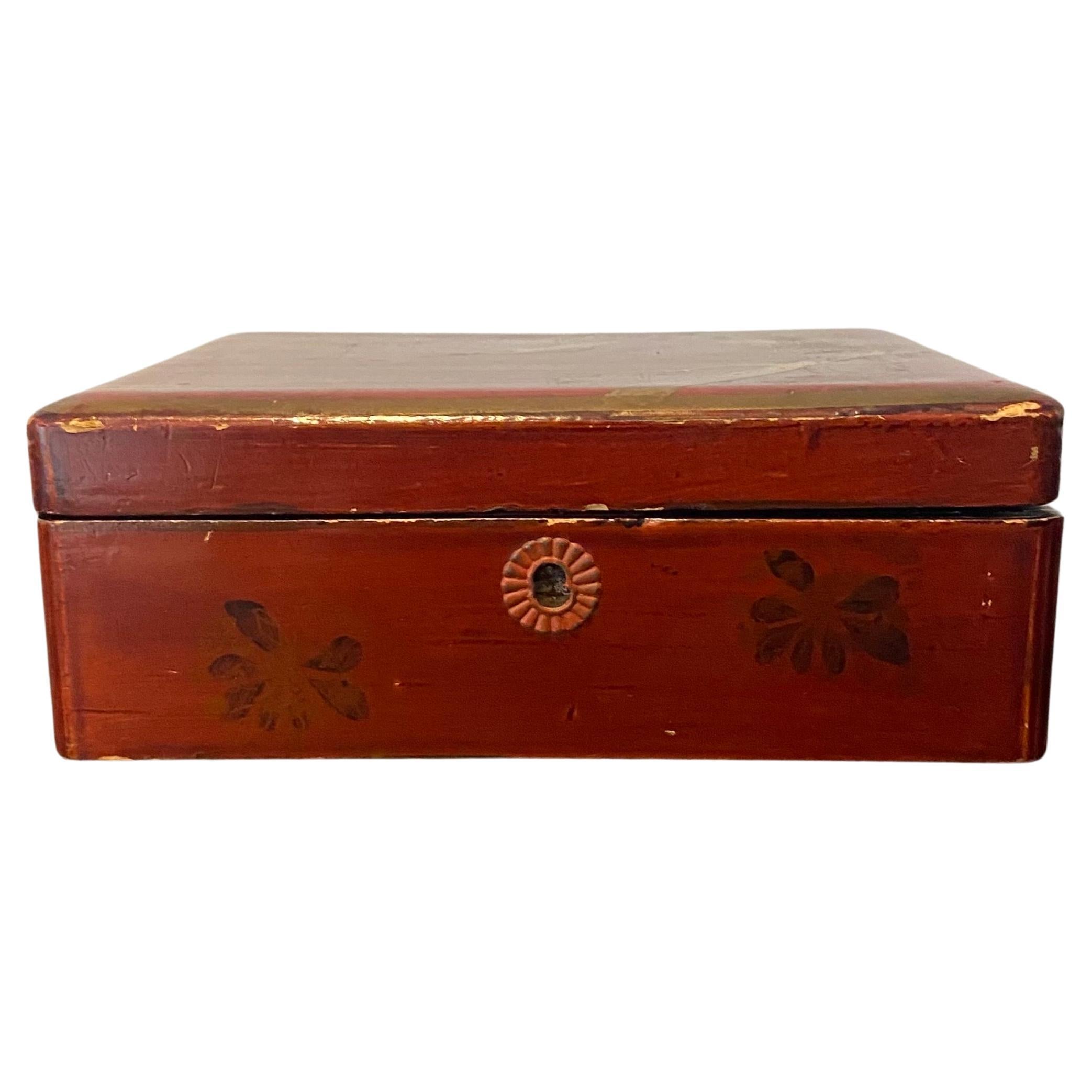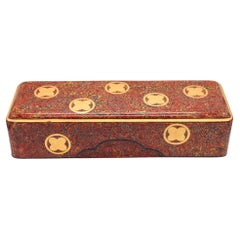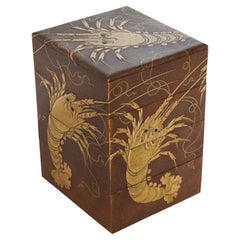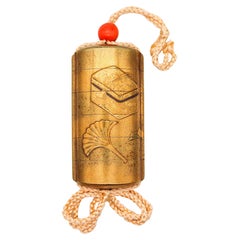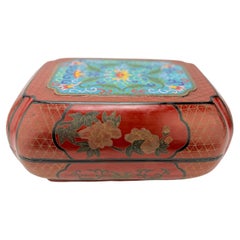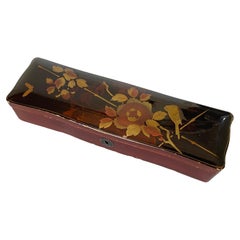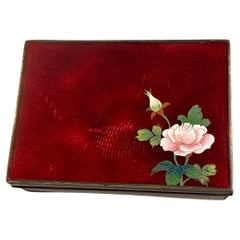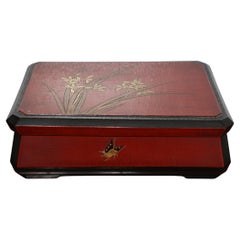Items Similar to JAPAN 1880 Meiji Period Tebako Box In Red Lacquered Wood With Abalone Inlaid
Want more images or videos?
Request additional images or videos from the seller
1 of 12
JAPAN 1880 Meiji Period Tebako Box In Red Lacquered Wood With Abalone Inlaid
$3,850per set
£2,892.23per set
€3,335.21per set
CA$5,342.38per set
A$5,936.56per set
CHF 3,110.82per set
MX$72,801.32per set
NOK 39,676.70per set
SEK 37,326.38per set
DKK 24,892.58per set
Shipping
Retrieving quote...The 1stDibs Promise:
Authenticity Guarantee,
Money-Back Guarantee,
24-Hour Cancellation
About the Item
Presentation Tebako box from the Japanese Meiji period (1868-1912).
Beautiful decorative presentation Tebako box from the Japanese Imperial Meiji period, circa 1880. This box has been meticulously crafted in a squared cushioned shape in wood with kara coating Kobayashi red lacquer, gilding, black lacquer and inlaid decorations of abalone shell, Raden. Tebako literally means "portable box", it is a toilet box containing the objects necessary for washing and make-up, especially blush mirror and little boxes. This is a great decorative box, actually to be used for any purpose and with great eye appeal.
Tsugaru Nuri Lacquer in The Kara Nuri Style
Tsugaru lacquerware originated in the Edo period (1603-1868), when the lord of the Hirosaki Domain (now part of Aomori Prefecture) invited a lacquer artisan from Wakasa Province (now Fukui Prefecture). In the Meiji period (1868-1912), Tsugaru lacquerware grew into a major local industry after the establishment of a lacquerware factory and a cooperative association. Tsugaru lacquerware gained worldwide recognition after it was exhibited at the Vienna World Exposition in 1873.
Raden
This is a Japanese decorative technique used for lacquerware and woodenware, in which linings of mother-of-pearl or of abalone shells are cut into designs and either glued onto or inserted into the surface of the lacquer or wood. There are several varieties of Raden lacquerware.
The Meiji Imperial Period
This is an era of Japanese history that extended from October 23, 1868 to July 30, 1912.The Meiji era was the first half of the Empire of Japan, when the Japanese people moved from being an isolated feudal society at risk of colonization by Western powers to the new paradigm of a modern, industrialized nation state and emergent great power, influenced by Western scientific, technological, philosophical, political, legal, and aesthetic ideas. As a result of such wholesale adoption of radically different ideas, the changes to Japan were profound, and affected its social structure, internal politics, economy, military, and foreign relations. The period corresponded to the reign of Emperor Meiji. It was preceded by the Keiō era and was succeeded by the Taishō era, upon the accession of Emperor Taishō.
Country: Imperial Japan,
Period: Meiji, 1880.
Materials: Wood, red and black lacquer, gold and abalone shell.
Weight: 550 Grams, (1.21 Pounds).
Measurements: 95 mm by 172 mm by 172 mm (3.75 x 6.75 x 6.75 Inches).
Signature: Signed in black lacquer in the underneath.
Condition: Basically, is in great antique condition, with minimal flea bites at the inside border due the usage, otherwise in great condition. All parts are secured in the settings. This presentation Tebako box has been carefully inspected to guarantee the condition and authenticity.
INVENTORY REF: D032425MNNN/.6745
- Dimensions:Height: 3.75 in (9.53 cm)Width: 6.75 in (17.15 cm)Depth: 6.75 in (17.15 cm)
- Sold As:Set of 2
- Style:Meiji (Of the Period)
- Materials and Techniques:
- Place of Origin:
- Period:
- Date of Manufacture:1880
- Condition:Wear consistent with age and use. Basically, is in great antique condition, with minimal flea bites at the inside border due the usage, otherwise in great condition. All parts are secured in the settings. This presentation Tebako box has been carefully inspected to be guarantee.
- Seller Location:Miami, FL
- Reference Number:Seller: D032425MNNN/.67451stDibs: LU8303244639362
About the Seller
5.0
Gold Seller
Premium sellers maintaining a 4.3+ rating and 24-hour response times
1stDibs seller since 2023
206 sales on 1stDibs
Typical response time: 3 hours
- ShippingRetrieving quote...Shipping from: Miami, FL
- Return Policy
Authenticity Guarantee
In the unlikely event there’s an issue with an item’s authenticity, contact us within 1 year for a full refund. DetailsMoney-Back Guarantee
If your item is not as described, is damaged in transit, or does not arrive, contact us within 7 days for a full refund. Details24-Hour Cancellation
You have a 24-hour grace period in which to reconsider your purchase, with no questions asked.Vetted Professional Sellers
Our world-class sellers must adhere to strict standards for service and quality, maintaining the integrity of our listings.Price-Match Guarantee
If you find that a seller listed the same item for a lower price elsewhere, we’ll match it.Trusted Global Delivery
Our best-in-class carrier network provides specialized shipping options worldwide, including custom delivery.More From This Seller
View AllJAPAN 1900 Meiji Period Fubako Box In Hiramaki-e Lacquered Wood With Gilding
Located in Miami, FL
Fubako letters-box from the Japanese Meiji period (1868-1912).
Beautiful decorative Fubako letters box from the Japanese Imperial Meiji period, circa 1900. This box has been meticul...
Category
Antique Early 1900s Japanese Meiji Lacquer
Materials
Gold
JAPAN Meiji Period 1870 Four Tiers Presentation Jubako Box Namiki Lacquer & Gold
Located in Miami, FL
Four Tier Japanese Gilt Jubako Maki-E box with red Interior.
This is a beautiful decorative presentation Jubako box created in the Imperial Japan during the early Meiji period (1868...
Category
Antique 1870s Japanese Meiji Lacquer
Materials
Gold
$4,360 Sale Price / set
20% Off
ALFRED DUNHILL Paris 1928 Louis Kuppenheim Enameled Japonisme Box 935 Sterling
By Louis Kuppenheim, Alfred Dunhill
Located in Miami, FL
An enameled box by Louis Kuppenheim for Alfred Dunhill.
This is an extraordinary and extremely rare desk box with double enameling. The box have been created in the city of Pforzhei...
Category
Vintage 1920s French Art Deco Decorative Boxes
Materials
Gold, Silver, Enamel
Japan 1800 Edo Period Six Drawer Inro In Lacquered Gilt Wood With Utensils
Located in Miami, FL
Japanese Inro from the Edo Period (1603-1867).
Beautiful Inro, created in Japan during the Edo period (Shogunate), circa 1800. It was carefully crafted in carved precious wood with ...
Category
Antique Early 1800s Japanese Edo Lacquer
Materials
Coral
$2,600 Sale Price
20% Off
Bardies-Faure 1914 Paris Edwardian Guilloche Enameled Box .950 Sterling Silver
Located in Miami, FL
A guilloche enameled round box designed by Bardies-Faure & Cie.
Fabulous French early 20th century enamel box, created in Paris during the Edwardian period, back in the 1914-1915. T...
Category
Vintage 1910s French Belle Époque Decorative Boxes
Materials
Silver, Sterling Silver, Enamel
$2,600 Sale Price
20% Off
Charles Thomae 1925 Art Deco Box with Red and Black Lacquer in Sterling Silver
By The Thomae Company
Located in Miami, FL
Art Deco lacquer box designed by Thomas.
An impressive, beautiful and colorful box, created in Attleboro Massachuchet by the Charles Thomae Company, ...
Category
Vintage 1920s American Art Deco Cigar Boxes and Humidors
Materials
Silver, Sterling Silver
$1,800 Sale Price
20% Off
You May Also Like
Chinese Cloisonne Mounted Red & Black Lacquer Box
Located in Atlanta, GA
This is a beautifully crafted lacquer box with a cloisonné enamel mount, featuring an intricate design that combines traditional craftsmanship with vibrant artistry. The lid showcase...
Category
20th Century Chinese Chinese Export Lacquer
Materials
Enamel
$716 Sale Price
20% Off
Red Japanese Lacquered Box Meiji Decorative Box, circa 1880
Located in Auribeau sur Siagne, FR
Nice Japanese glove box in red and black lacquered wood dating from the end of the 19th century. It is decorated with delicate gold, black and white flowers and foliage on all its vi...
Category
Antique 19th Century Japanese Meiji Decorative Boxes
Materials
Lacquer, Wood
$335 Sale Price
20% Off
Japanese Red Ginbari Cloisonne Trinket Box, Meiji Period, circa 1900, Japan
Located in Austin, TX
A rich and elegant Japanese export red ginbari cloisonne trinket box, Meiji Period, circa 1900, Japan.
The attractive Japanese cloisonne box features a striking textured red ginbari...
Category
Antique Early 1900s Japanese Meiji Decorative Boxes
Materials
Metal, Copper, Enamel, Foil
Japanese late Meiji period A Large Organizer Red Lacquered Box, Ric.052
Located in Norton, MA
Japanese late Meiji period A Large Organizer Red Lacquered Box, decorated with irises and butterflies in gold and black.
Category
Antique 19th Century Japanese Decorative Boxes
Materials
Lacquer
Japan Red Lacquered Box 19th century
Located in Beuzevillette, FR
Beautiful Japanese box in red lacquered wood.
The lid is decorated with golden herons and flowering tree branches and signed by the artist. Black flowers are painted around the box.
...
Category
Antique Late 19th Century Decorative Boxes
Materials
Wood
Antique Chinese Cinnabar Lacquered Rectangular Box and Cover, China, circa 1880,
Located in Auribeau sur Siagne, FR
Red lacquer box with the lid representing a scholar and children playing in a mountainous garden, the outer sides covered with repeated geometric patterns. This box was made in China...
Category
Antique Late 19th Century Asian Chinese Export Jewelry Boxes
Materials
Wood, Lacquer
More Ways To Browse
Red Lacquer Furniture
Red Japanese Furniture
Black Gold Lacquer
Black And Red Lacquer
Japanese Wood Crafts
Meiji Wood
Imperial Japan
Meiji Wood Furniture
Lacquered Boxes Modern
Emperor Japan
Red Lacquer Box
Red Lacquer Mirror
Japanese Lacquer Boxes
Lacquer Mirror Antique
Shell Inlaid Boxes
Military Box
Inlaid Wood Mirror
Vienna 1880
